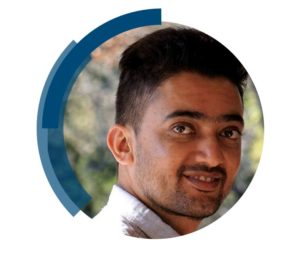Hemant Joshi recently published his first independent research article with ChemComm. We wanted to celebrate this exciting milestone by finding out more about Hemant and his research. Check out his #ChemComm1st article: Selenium coordinated palladium(II) trans-dichloride molecular rotor as catalyst for site selective annulation of 2‐arylimidazo[1,2‐a]pyridines
What are the main areas of research in your lab and what motivated you to take this direction?
We are a young research group who started in July 2019. Our research group mainly works on two different research areas: molecular rotors chemistry and homogenous catalysis by pincer complexes. We are trying to develop new and better catalysts for site-selective catalysis. The main motivation behind choosing these fields is my early training as a chemist in homogeneous catalysis and the interesting yet challenging chemistry associated with these fields.
Can you set this article in a wider context?
Our article describes first synthesis of a new class of intramolecular secondary interactions (SeCH…Cl) controlled molecular rotors having Cl−Pd−Cl rotor attached to Se−Pd−Se axle. These molecular rotors showed low rotational barriers which is essential for these molecular machines. The rotor was used as a catalyst for annulation of 2‐arylimidazo[1,2‐a]pyridines. The molecular rotor catalyst was designed in such a way that phenyl ring of ligand is involved in CH−π interactions with 2‐arylimidazo[1,2‐a]pyridines, which interestingly leads to revers regioselective annulated product which is otherwise challenging to obtain.
What do you hope your lab can achieve in the coming year?
Currently, the main focus is to build my independent research profile at CuRaj and to extend the possible network of collaborations to explore more challenging problems in the future. Our group’s main focus is to develop unidirectional molecular rotors with low rotational barriers.
Describe your journey to becoming independent researcher.
Since my early academic days, I was more inclined towards experimental chemistry which was the main driving force for me to choose a chemistry major during my masters. As a PhD research scholar, I joined Dr. Ajai K. Singh’s lab at the Indian Institute of Technology Delhi, India. My doctoral work was mainly focused on synthesis of new air stable metal complexes and metal chalcogenide nanoparticles for catalytic organic synthesis. To further strengthen my training as a chemist and to gain interdisciplinary research experiences, I started my post-doctoral research in Prof. John A. Gladysz’s laboratory at the Texas A&M University, College Station, USA. In Dr. Gladysz’s lab I was introduced to the beautiful word of molecular gyroscopes. Training with both of my previous advisors helped me to learn about how research labs function, and how to carry out projects and run the lab. The training from these labs built the foundation of my independent research which I would like to take up at CuRaj.
What is the best piece of advice you have ever been given?
The two best pieces of advice which helped me are from my parents and my research advisor. The first: to be a better human being and help others which helped in my personal life. The second which was useful in my professional career: run behind solving problems and not high impact factors.
Why did you choose to publish in ChemComm?
ChemComm is renowned journal known to publish interdisciplinary research with urgency. Our research group is glad to start with ChemComm.
Dr. Hemant Joshi is an Assistant Professor of Chemistry at Central University of Rajasthan (CuRaj), India. Hemant obtained his undergraduate (BSc) degree in chemistry from University of Rajasthan, India (2008) and master’s degree from Malaviya National Institute of Technology Jaipur, India (2010). After completing his master’s degree, Hemant joined the PhD program at the Indian Institute of Technology Delhi, India in 2010. His thesis work with Prof. Ajai K. Singh was focused on synthesis of new air stable metal complexes and metal chalcogenide nanoparticles for catalytic organic synthesis. In early 2016, Hemant joined the laboratory of Prof. John A. Gladysz at the Texas A&M University, College Station, USA. In his post-doctoral research work, he was engaged in building new molecular gyroscopes with large cage sizes and understanding their rotational behaviors. Hemant moved back to India in August 2018, and joined BITS Pilani, Pilani Campus, as DST Inspire faculty. In July 2019, Hemant started his independent research career at Central University of Rajasthan. Find him on Twitter: @hkjiitd











